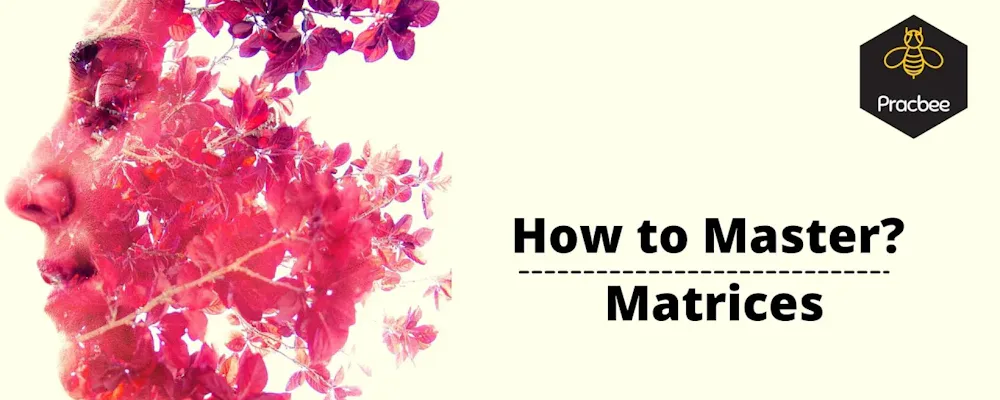

Matrices are an essential part of IIT JEE preparation, and mastering this topic can significantly boost your overall score in mathematics. The concept of matrices is not only crucial for JEE Main but also plays a significant role in JEE Advanced, where questions tend to be more conceptual and application-based. In this blog, we will break down the steps to master matrices, discuss the frequently asked questions, and provide some expert tips to help you excel in this topic.
If you're looking for a detailed video explanation, you can watch this video
Before diving deep into the topic of matrices, it is essential to have a firm grasp of the basic definitions and operations. This includes:
Matrix definition: A matrix is a rectangular array of numbers arranged in rows and columns.
Types of matrices: Identity matrix, zero matrix, diagonal matrix, and symmetric matrix.
Matrix operations: Addition, subtraction, scalar multiplication, and matrix multiplication.
The IIT JEE exam often tests your understanding of the fundamental properties of matrices and matrix operations. Ensure you know how to perform these operations correctly and efficiently.
Make sure to focus on the properties of matrices, such as commutativity in matrix addition and the associative property in matrix multiplication. These properties often serve as the foundation for solving JEE Advanced questions.
In IIT JEE, questions often revolve around using elementary row and column operations to simplify a matrix or find its inverse. To master this:
Learn how to apply elementary operations step by step.
Practice solving systems of linear equations using matrices and row reduction techniques.
Elementary row operations are critical when solving problems involving inverse matrices or when simplifying matrices to their reduced row-echelon form. These techniques are heavily tested in JEE Advanced, especially when dealing with a system of equations.
Determinants are closely related to matrices and are crucial in JEE Advanced. You should:
Understand how to calculate the determinant of a matrix.
Know the properties of determinants, such as linearity, the effect of row swaps, and the relationship between a matrix and its determinant.
Many JEE questions require you to apply properties of determinants, especially when dealing with larger matrices (3x3 or higher). Make sure you understand how these properties can simplify your calculations.
Finding the inverse of a matrix is another important concept. For IIT JEE, you need to be comfortable with:
Matrix inversion: Learn how to find the inverse of a matrix using the adjoint method and row operations.
Understand how to apply the inverse matrix in solving a system of linear equations.
Matrix inversion is crucial for solving systems of linear equations. In JEE Advanced, you are often asked to solve complex systems using this technique, which makes it a must-master area.
One of the most common applications of matrices is solving systems of linear equations. For IIT JEE, you should be familiar with:
Cramer's Rule Matrix method
Gauss elimination method
Understanding how to apply these methods to solve linear systems is important for JEE Advanced
problems, where the system of equations might involve multiple variables and constraints.
In the IIT JEE Advanced, many of the matrix-related questions are application-based. This means the examiners may present you with a real-world problem that you need to model and solve using matrices.
Transformation of geometric figures using matrices.
Markov chains and their applications in probability problems.
Graph theory and its matrix representation.
To master application-based problems, make sure you are comfortable with translating real-world situations into mathematical models involving matrices. Practicing past year JEE questions is a great way to develop this skill.
Once you have a strong foundation in the basics and applications of matrices, it's time to move on to advanced concepts. For JEE Advanced, focus on:
Eigenvalues and eigenvectors Diagonalization of matrices Rank of a matrix
These concepts are often tested in JEE Advanced, and mastering them will help you tackle the more difficult problems in the exam.
Here are a few tips to improve your speed and accuracy in solving matrix-related problems:
Solve JEE Previous Year Questions: Start with JEE Main questions and gradually move on to JEE Advanced problems. This will help you get familiar with the pattern of questions and the difficulty level.
Time yourself: While practicing, try to solve each problem within a time limit. This will help you manage your time better during the actual exam.
Use shortcuts and tricks: Learn matrix-specific shortcuts and tricks that can help you solve problems faster. For example, use matrix properties to simplify complex matrix multiplications.
When preparing for IIT JEE, students often make the following mistakes with matrices:
Neglecting the basics: Many students jump straight into advanced problems without fully mastering the basics. Ensure that you are comfortable with the foundational concepts before moving on.
Forgetting matrix properties: Many students overlook the properties of matrices and
determinants, which can simplify complex problems.
Poor time management: Matrices can be time-consuming if you don't know how to approach them efficiently. Practice solving matrix problems under timed conditions to improve your speed.
The key to mastering matrices for IIT JEE is consistent practice. Make sure to:
Solve a variety of problems, including both conceptual and application-based questions. Focus on the areas where you are weak and work on improving them.
Take mock tests to simulate exam conditions and improve your time management skills.
For more insights into how to tackle matrix problems, make sure to watch this
Matrices are a crucial topic for IIT JEE, and mastering them requires a solid understanding of both the basic concepts and their applications. By focusing on the properties of matrices, practicing different types of questions, and avoiding common mistakes, you can excel in this section of the exam. Remember, consistent practice and efficient problem-solving strategies are the keys to success.